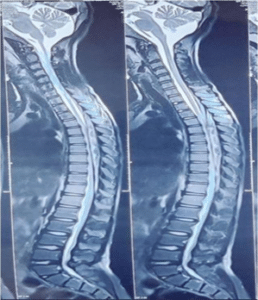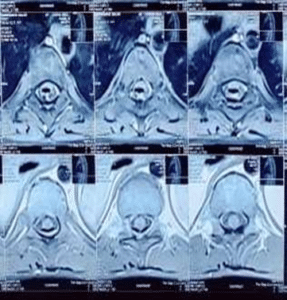Pranab Jyoti Borah1*, Dhrubabrat Puzari2, Sajid Hussain3, Saket Saraf3, Pallab Saikia3
1Associate Professor, Department of Orthopaedics, Lakhimpur Medical College, North Lakhimpur, Assam
2Registrar, Department of Orthopaedics, Assam Medical College, Dibrugarh, Assam
3Post Graduate Trainee, Department. of Orthopaedics, Assam Medical College, Dibrugarh, Assam
*Correspondence author: Pranab Jyoti Borah, Associate Professor, Department of Orthopaedics, Lakhimpur Medical College, North Lakhimpur, Assam; Email: drpjborah1981@gmail.com
Published Date: 04-02-2024
Copyright© 2024 by Borah PJ, et al. All rights reserved. This is an open access article distributed under the terms of the Creative Commons Attribution License, which permits unrestricted use, distribution, and reproduction in any medium, provided the original author and source are credited.
Abstract
An excess of adipose tissue buildup restricted to the lumbar and thoracic areas of the spine is the cause of spinal epidural lipomatosis. The etiology of spinal epidural lipomatosis can be broadly categorized based on five often related risk factors: obesity, endogenous steroid hormonal disease, spine surgery, exogenous steroid use and idiopathic disease. However, the actual pathophysiology of the condition remains unclear. Neurological impairments, myelopathy, radiculopathy, neurogenic claudication, loss of sensation, difficulties voiding, lower extremity weakness and infrequently cauda equina syndrome might result from the progression of spinal epidural lipomatosis.
Conservative treatment focuses on reducing symptoms that result from common risk factors and is primarily patient-specific. Open surgical procedures and minimally invasive surgery have shown to be effective if more advanced means of treatment are required. Here, we report an unusual case of idiopathic spinal epidural lipomatosis. Treatment will depend on the neurological status of the patient. We opted to manage the patient conservatively and closely monitor her on follow up visits.
Keywords: Spinal Epidural Lipomatosis; Exogenous Steroid Use; Myelopathy; Cauda Equina Syndrome
Introduction
A well-known but somewhat uncommon disorder called spinal epidural lipomatosis is characterized by an overabundance of epidural adipose tissue growing inside the spinal canal. Despite the fact that symptomatic spinal epidural lipomatosis should be treated, it is merely an accumulation of fat in the canal. Although spinal epidural lipomatosis can occur without symptoms, patients frequently exhibit signs of compression of the nerves or spinal cord. A key contributing factor to spinal epidural lipomatosis is steroids; Lee, et al., reported the first instance of steroid-induced spinal epidural lipomatosis following renal transplantation in 1975 [1]. Spinal epidural lipomatosis is presently believed to be caused by a number of illness states, including long-term exogenous steroid usage, exposure to endogenous steroids as a result of endocrine disorders, obesity, alterations following surgery and idiopathic diseases [2]. The term “idiopathic disease” is defined differently in the literature. While some authors use it to represent Spinal epidural lipomatosis linked with obesity or another unknown cause, others use it to denote Spinal epidural lipomatosis of an unknown etiology. Idiopathic Spinal epidural lipomatosis is defined by our group as a disease that affects non-obese patients who have no known underlying disorder. In this case report we present a case of idiopathic spinal epidural lipomatosis presenting with unilateral lower limb spasticitity, weakness at level of toes and ankle and presence of clonus.
Case Report
This patient a 11-year-old female presenting with complaints of difficulty in walking for last 5 months. It was gradual in onset and slowly progressive. The patient noticed weakness when she woke up and was unable to move her left lower limb as usual.
Initially there was difficulty in wearing sandals in the left foot. The left lower limb developed weakness which was ascending in nature. The toes were involved first followed by ankle. Bowel and bladder habits are normal. There was no complains of backache or presence of any constitutional symptoms. No history of any steroid intake, no anti thyroid drug intake, etc. The patient has not yet attended menarche.
General physical examination reveals non-obese girl child without any evidence of endocrinopathies. Local examination of spine reveals no deformity or tenderness High stepping gait was observed in gait analysis. Neurological examination reveals increased tone of left lower limb with spasticity. There is extensor plantar reflex bilaterally. Plantar clonus is present on left side. Muscle bulk was equal and preserved in bilateral lower limb. Power at toes and ankle of left lower limb is 3/5 (Medical Research Council Grading) and the power is intact at the upper levels of left lower limb and all levels of right lower limb. Sensation is intact at all levels. She was diagnosed to have compressive myelopathy in cervico-dorsal region. Haematological and Biochemical investigation reports were normal. CSF analysis was not done. X-ray of spine was within normal limits and Magnetic Resonance Imaging of LS spine with screening of whole spine reveals disc desiccation. A well-defined extra medullary and extra dural T1 T2 weighted hyper intense image showing heterogeneous suppression on T2 fat suppression extending from C7 to D12 vertebra level leading to severe secondary spinal canal stenosis with maximum 2.4 mm behind D7 vertebral body. The lesion doesn’t show diffusion restriction on diffusion weighted image and no enhancement on post contrast scan. However, the lesion shows of separation on post contrast T1 fat suppression sequence (Fig. 1-4). The MRI report is suggestive of epidural lipomatosis. The patient was discharged on methylcobalamin supplementation and subsequent follow ups revealed no significant change in neurological status of the patient.

Figure 1: T2W FS image showing epidural lipomatosis from C7 to D12.

Figure 2: T1W image showing epidural lipomatosis from C7 to D12.

Figure 3: Narrowing of canal diameter on cross sectional T2W image.

Figure 4: Narrowing of canal diameter on cross sectional T2W FS image.
Discussion
Unencapsulated fat is abnormally deposited in the epidural space in spinal epidural lipomatosis [3]. Excessive steroid levels are typically linked to this condition, either through excess steroid secretion by the body (as in Cushing’s disease or some other endocrinopathies like hypothyroidism or morbid obesity) or steroid administration (as in some diseases like systemic lupus erythematosis, Vasculitis, etc) [3-5]. These are treated as idiopathic kinds in certain situations where no such reason can be identified [6]. Although patients receiving large doses of glucocorticoids are more likely to experience spinal epidural lipomatosis, cases have also been described with low steroid dosages as low as 15 mg prednisone daily, even for a brief duration [7,8]. Centripetal fat accumulation is a feature of Cushings syndrome [9]. It is uncommon for fat to lodge in the epidural region and compress the spinal cord, resulting in neurological impairments and localized pain [9]. Compressive myelopathy, radiculopathy and cauda equina are examples of neurologic impairments that can manifest as symptoms of muscle weakness, sensory loss or aberrant reflexes [6]. There could be a low backache.
Neurological aspects typically develop gradually over several months, while there have also been reports of fast onset relapsing and remitting courses and sensory abnormalities [10,11]. The unique aspect of our case was its unilateral nature, lack of concomitant endocrinopathies and history of exogenous steroid use.
Prevalence is more in males than in females, with 75% of reported cases being males [11-13]. Thoracic spine being affected more than the lumbar region, while epidural lipomatosis of the cervical spine has not been reported till now [14,15].
MRI spine is diagnostic choice of imaging. It shows uniformly hyperintense fat collection in epidural space on both T1W1 and T2W1 sequences.
The severity of the neurological impairments determines the course of treatment. Many individuals have claimed success with conservative treatment, such as weight loss and exogenous steroid tapering or crushing disease treatment [4,16]. Our patient is neither obese nor having excess steroids (endogenous production or exogenous administration). Surgical intervention, such as laminectomy and removal of epidural adipose tissue, is indicated in cases of severe progressive neurological impairments [3,6,11]. Most patients respond well to decompressive treatment and following surgery, they may see neurological improvement. After surgical intervention, the prognosis for idiopathic spinal epidural lipomatosis is good and there have been no documented occurrences of recurrence after surgery [3]. Our patient was not obese, without any endocrinopathy and presented with unilateral left lower limb weakness, which is quite rare.
Conclusion
To sum up, epidural lipomatosis of the spine should be taken into account as a differential diagnosis when determining the cause of an epidural mass that is causing compressive myelopathy and a paraparesis, the course of which is regressive and intermittent. It could exist in persons who are not fat or who do not have endocrinopathies. Early identification is crucial since modest symptoms may resolve with conservative treatment while advanced and progressive disease requires surgical intervention. A contrast enhanced MRI spine is a diagnostic tool.
Conflict of Interests
The author has no conflict of interest to declare.
References
- Lee M, Lekias J, Gubbay SS, Hurst PE. Spinal cord compression by extradural fat after renal transplantation. Med J Aust. 1975;1(7):201-3.
- Fassett DR, Schmidt MH. Spinal epidural lipomatosis: a review of its causes and recommendations for treatment. Neurosurg Focus. 2004;16(4):E11.
- Fogel GR, Cunningham PY, Esses SI. Spinal epidural lipomatosis: case reports, literature review and meta-analysis. Spine J Off J North Am Spine Soc. 2005;5(2):202-11.
- Maillot F, Mulleman D, Mammou S, Goupille P, Valat JP. Is epidural lipomatosis associated with abnormality of body fat distribution? A case report. Eur Spine J. 2006;15(1):105-8.
- Beges C, Rousselin B, Chevrot A, Godefroy D, Vallee C, Berenbaum F, et al. Epidural lipomatosis. Interest of magnetic resonance imaging in a weight-reduction treated case. Spine. 1994;19(2):251-4.
- Robertson SC, Traynelis VC, Follett KA, Menezes AH. Idiopathic spinal epidural lipomatosis. Neurosurgery. 1997;41(1):68-74.
- Archer CR, Smith KR. Extradural lipomatosis simulating an acute herniated nucleus pulposus. Case report. J Neurosurg. 1982;57(4):559-62.
- Tobler WD, Weil S. Epidural lipomatosis and renal transplantation. Surg Neurol. 1988;29(2):141-4.
- Haid RW, Kaufman HH, Schochet SS, Marano GD. Epidural lipomatosis simulating an epidural abscess: case report and literature review. Neurosurgery. 1987;21(5):744-7.
- López-González A, Resurrección Giner M. Idiopathic spinal epidural lipomatosis: urgent decompression in an atypical case. Eur Spine J Off Publ Eur Spine Soc Eur Spinal Deform Soc Eur Sect Cerv Spine Res Soc. 2008;17 Suppl 2:S225- 7.
- Akhaddar A, Ennouali H, Gazzaz M, Naama O, Elmostarchid B, Boucetta M. Idiopathic spinal epidural lipomatosis without obesity: a case with relapsing and remitting course. Spinal Cord. 2008;46(3):243-4.
- Özgür Ö. Acute onset paraplegia due to thoracic angiolipoma: a case report and review of the literature. Biomed J Sci Tech Res. 2020;27(2).
- Roy-Camille R, Mazel C, Husson JL, Saillant G. Symptomatic spinal epidural lipomatosis induced by a long-term steroid treatment. Review of the literature and report of two additional cases. Spine. 1991;16(12):1365-71.
- Plotz CM, Knowlton AI, Ragan C. The natural history of Cushing’s syndrome. Am J Med. 1952;13(5):597-614.
- Santini LC, Williams JL. Mediastinal widening (presumable lipomatosis) in Cushing’s syndrome. N Engl J Med. 1971;284(24):1357-9.
- Wälchli B, Benini A. Spinal epidural lipomatosis. Swiss Med Wkly. 2001;131(23-24):359.
Article Type
Case Report
Publication History
Accepted Date: 11-01-2024
Accepted Date: 26-01-2024
Published Date: 04-02-2024
Copyright© 2024 by Borah PJ, et al. All rights reserved. This is an open access article distributed under the terms of the Creative Commons Attribution License, which permits unrestricted use, distribution, and reproduction in any medium, provided the original author and source are credited.
Citation: Borah PJ, et al. An Unusual Case of Idiopathic Spinal Epidural Lipomatosis. J Ortho Sci Res. 2024;5(1):1-5.

Figure 1: T2W FS image showing epidural lipomatosis from C7 to D12.

Figure 2: T1W image showing epidural lipomatosis from C7 to D12.

Figure 3: Narrowing of canal diameter on cross sectional T2W image.

Figure 4: Narrowing of canal diameter on cross sectional T2W FS image.


